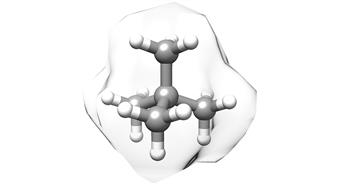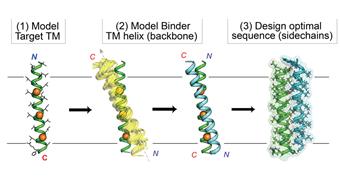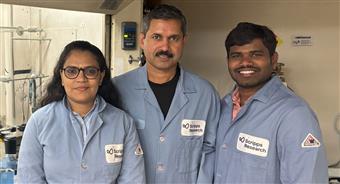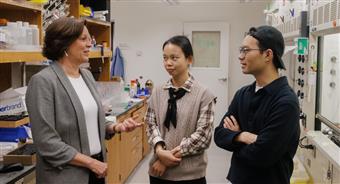
New technology allows control of gene therapy doses
December 26, 2019
JUPITER, FLA Scientists at Scripps Research in Jupiter have developed a special molecular switch that could be embedded into gene therapies to allow doctors to control dosing.
The feat, reported in the scientific journal Nature Biotechnology, offers gene therapy designers what may be the first viable technique for adjusting the activity levels of their therapeutic genes. The lack of such a basic safety feature has limited the development of gene therapy, which otherwise holds promise for addressing genetically based conditions. The scientists' technique appears to solve a major safety issue and may lead to more use of the strategy.
The Scripps Research team, led by principal investigator Michael Farzan, PhD, demonstrated the power of their new switching technique by incorporating it into a gene therapy that produces the hormone erythropoietin, used as a treatment for anemia. They showed that they could suppress expression of its gene to very low levels with a special embedded molecule, and could then increase the gene's expression, over a wide dynamic range, using injected control molecules called morpholinos that the U.S. Food and Drug Administration has found to be safe for other applications.
I think that our approach offers the only practical way at present to regulate the dose of a gene therapy in an animal or a human, Farzan says.
Gene therapies work by inserting copies of a therapeutic gene into the cells of a patient, if, for example, the patient was born without functional copies of the needed gene. The strategy has long been seen as having enormous potential to cure diseases caused by defective genes. It also could enable patients to receive a steady, long-term delivery of therapeutic molecules that are impractical to deliver in pills or injections because they don't survive for long in the body.
However, gene therapies have been viewed as inherently risky because once they are delivered to a patient's cells, they cannot be switched off or modulated. As a result, only a handful of gene therapies have been FDA-approved to date.
The simplicity of the technique, and the fact that morpholinos are already FDA-approved, could allow the new transgene switching system to be used in a wide variety of envisioned gene therapies, Farzan adds.
Farzan's team, including study co-first authors Guocai Zhong, PhD and Haimin Wang, respectively a postdoctoral researcher and a research assistant in the Farzan lab, crafted a transgene switch from a family of ribonucleic acid (RNA) molecules called hammerhead ribozymes. These ribozymes have the remarkable property that they cut themselves in two as soon as they are copied out into RNA from the DNA that encodes them.
A therapeutic transgene containing the DNA of such a ribozyme will thus be copied out in cells into strands of RNA, called transcripts, that will tend to separate into two pieces before they can be translated into proteins. However, this self-cleaving action of the ribozyme can be blocked by RNA-like morpholinos that latch onto the ribozyme's active site; if this happens, the transgene transcript will remain intact and will be more likely to be translated into the therapeutic protein.
The ribozyme thus effectively acts as an off switch for the transgene, whereas the matching morpholinos, injected into the tissue where the transgene resides, can effectively turn the transgene back on again to a degree that depends on the morpholino dose.
The scientists started with a hammerhead ribozyme called N107 that had been used as an RNA switch in prior studies, but they found that the difference in production of a transgene-encoded test protein between the off and on state was too modest for this ribozyme to be useful in gene therapies. However, over months of experimentation they were able to modify the ribozyme until it had a dynamic range that was dozens of times wider.
The team then demonstrated the ribozyme-based switch in a mouse model of an EPO gene therapy, which isn't yet FDA-approved but is considered potentially better than current methods for treating anemia associated with severe kidney disease. They injected an EPO transgene into muscle tissue in live mice, and showed that the embedded ribozyme suppressed EPO production to a very low level.
Injection of a small dose of the morpholino molecules into affected tissue strongly reversed that suppression, allowing EPO production to rise by a factor of more than 200 and stay there for more than a week, compared to a half-life of a few hours for EPO delivered by a standard injection. Those properties make the ribozyme-based switch potentially suitable for real clinical applications.
We got what I would have said before was an impossible range of in vivo regulation from this system, Farzan says.
Farzan and his colleagues are now working to adapt their ribozyme switch technique so that it can be used as a gene therapy failsafe mechanism, deactivating errant transgenes permanently.
Authors of the study, A reversible RNA on-switch that controls gene expression of AAV-delivered therapeutics in vivo, include Guocai Zhong, Haimin Wang, Wenhui He, Yujun Li, Huihui Mou, Zachary Tickner, Mai Tran, Tianling Ou, Yiming Yin, Huitian Diao, and Michael Farzan of Scripps Research.
Funding for the research was provided by the National Institutes of Health (R37 AI091476, AI1129868, DP1 DA043912 199).
Immunology & Microbiology Farzan, Michael
More from Scripps
20/04/2024
New copper-catalyzed C-H activation strategy from Scripps Research Two-mode reactions inspired by human detox enzymes offer powerful new tools for drug discover...
12/04/2024
Scripps Research chemists devise easier new method for making a common type of building block for drugs Scientists transform simple linear amines into saturated...
06/04/2024
A simple, inexpensive way to make carbon atoms bind together A Scripps Research team uncovers a cost-effective method for producing quaternary carbon molecules,...
04/04/2024
Developing a vaccine for the zombie drug xylazine Scripps Research chemical biologists design an early proof-of-concept vaccine that could lead to the first...
30/03/2024
How blocking a neural receptor responsible for addiction could reduce alcohol use A Scripps Research team found that a new therapeutic that targets the kappa op...
13/03/2024
New computational strategy boosts the ability of drug designers to target proteins inside the membrane Customized-design approach could streamline the design of...
29/02/2024
Scripps Research scientists reveal how first cells could have formed on Earth New phospholipid discovery brings researchers closer to understanding how primordi...
29/02/2024
How molecular handedness emerged in early biology Scripps Research chemists fill a major gap in origin-of-life theories.
February 28, 2024
LA JOLLA, CA Mole...
22/02/2024
Snaking toward a universal antivenom Scripps Research scientists discovered antibodies that protect against a host of lethal snake venoms.
February 21, 2024
...
06/02/2024
Calibr-Skaggs announces expansion of option and license agreement with AbbVie to develop novel cell therapies for solid tumors and autoimmune diseases
AbbVie...
26/01/2024
Re-energizing mitochondria to treat Alzheimer's disease Scripps Research team restored neuron-to-neuron connections in human cells.
January 25, 2024
LA JO...
24/01/2024
100 years of Science Changing Life: Scripps Research celebrates a century of transforming human health For the last century, institute leaders and renowned scie...
23/01/2024
New technology lets researchers track brain cells' off switches The method could shed light on what goes awry in numerous brain conditions when neurons ar...
09/01/2024
Three decades of giving: Announcing the Calibr-Skaggs Institute for Innovative Medicines The ALSAM Foundation, founded by the Skaggs family, provides lasting g...
04/01/2024
Life science entrepreneur Gene Lay joins Scripps Research Board of Directors Lay, founder of the global biotech company BioLegend, brings invaluable experience ...
21/12/2023
Taming a plant-derived toxin Scripps Research team modifies the traditional poison picrotoxinin for potential neurological drugs and anti-parasite treatments. ...
19/12/2023
Scripps Research Executive Vice President Eric Topol gives TED talk on transformative power of AI in medicine Topol provides an overview of how AI models can i...
13/12/2023
New AI-powered algorithm could better assess people's risk of common heart condition Early detection of atrial fibrillation can reduce the risk of stroke an...
07/12/2023
Nanoparticle flu vaccine design shows promise in early tests Scripps Research-designed vaccine could provide broad, enduring protection against influenza A str...
16/11/2023
Numerous Scripps Research scientists named Highly Cited Researchers Clarivate's annual, global list represents researchers who have demonstrated significant...
07/11/2023
Multiple sclerosis drug invented at Scripps Research slows long-term devastating disease progression Late-breaking data reinforces the effectiveness and safety ...
05/10/2023
Keren Lasker named a 2023 Moore Inventor Fellow The prestigious award will support Lasker's inventive research in membraneless organelles and their applica...
22/09/2023
Michael Bollong named a 2023 Amgen Young Investigator The prestigious award will support Bollong's research identifying new molecular targets and therapeuti...
09/09/2023
Philip Dawson receives 2024 American Chemical Society National Award Dawson is honored with the Arthur C. Cope Late Careers Scholar Award for his foundational c...
07/09/2023
Scripps Research chemists devise a method for C-H activation of alcohols The method represents a new toolkit for making drugs and other compounds.
September 06...
31/08/2023
Scripps Research receives $1.5M to surveil infectious disease threats in wastewater Bill & Melinda Gates Foundation award to support the development of multi-pa...
16/08/2023
How cold temperatures trigger the brain to boost appetite Scripps Research scientists' discovery could lead to new weight loss and metabolic health treatmen...
08/08/2023
Human antibody that targets carfentanil, fentanyl and related opioids reverses overdose effects in preclinical study Scripps Research-developed antibody therapy...
04/08/2023
How sensory neurons impact the gut Scripps Research scientists show that the receptor PIEZO2 in sensory neurons controls gut motility and transit time, which a...
26/07/2023
AbbVie and Calibr Expand Strategic Collaboration to Advance Several Preclinical and Early-stage Clinical Assets The expanded strategic collaboration will advan...
23/07/2023
Scripps Research scientists develop AI-based tracking and early-warning system for viral pandemics Machine-learning system effectively predicts emergence of pro...
19/07/2023
Monitoring T cells may allow prevention of type 1 diabetes Scripps Research study shows that analyzing T cells in blood samples could be used to select at-risk ...
19/07/2023
Scripps Research mourns passing of leading organic chemist Albert Eschenmoser Eschenmoser pioneered key reactions in synthetic chemistry and shaped the understa...
15/06/2023
Scripps Research awarded $46.8 million by NIH to promote human health through innovative translational science and training The Translational Institute is harne...
13/06/2023
Scripps Research's Danielle Grotjahn named 2023 Pew Scholar in the Biomedical Sciences The award will support Grotjahn's study of how cells assemble the...
31/05/2023
Crossing the ring: new method enables C-H activation across saturated carbocycles Scripps Research chemists add another powerful tool to their molecular editin...
24/05/2023
Scripps Research develops behind-the-scenes tool for better biomedical data discovery The new resource makes datasets more discoverable for life science communi...
19/05/2023
Scripps Research neuroscientist Hollis Cline elected to American Academy of Arts and Sciences Cline is recognized for her discoveries about the role of sensory ...
19/05/2023
Scripps Research's Skaggs Graduate School awards doctoral degrees to 31st graduating class Commencement ceremony will be livestreamed via Zoom and on instit...
13/05/2023
A better route to benzocyclobutenes, sought-after building blocks for drugs Scripps Research chemists devise a new, C-H activation-based method for the synthesi...
09/05/2023
Renowned Scripps Research professor Jeffery Kelly elected to National Academy of Sciences Kelly's groundbreaking work on protein misfolding has led to thera...
28/04/2023
Mirror-image molecules pave new path for cancer drug discovery By comparing how mirror image versions of small molecules impact clusters of proteins, Scripps R...
22/04/2023
How alcohol consumption contributes to chronic pain A Scripps Research team showed how both alcohol intake and alcohol withdrawal can lead to increased pain and...
21/04/2023
Xin Jin receives dual awards to study autism risk genes in neurodevelopment Major grants from the National Institutes of Health and California Institute for Reg...
20/04/2023
Trim the sugar: New HIV vaccine design improves immune response Scripps Research vaccine candidate headed for clinical trials.
April 19, 2023
LA JOLLA, CA A...
18/04/2023
Therapeutic can seek and destroy potent opioid to treat overdoses Scripps Research chemists developed a new biologic to work against the synthetic opioid carfen...
07/03/2023
How heavy alcohol consumption increases brain inflammation The findings by a Scripps Research team point toward a potential new drug target for treating alcohol...
02/03/2023
Scientists find human antibodies that can block multiple coronaviruses including SARS-CoV-2 Results from a Scripps Research and UNC team pave the way for a vacc...
28/02/2023
$10 million grant funds Scripps Research Alcohol Research Center through its 50th year The five-year grant supports research into the neurobiology of alcohol us...
28/02/2023
Immune system drug shows promise in treating alcohol use disorder, a Scripps Research clinical trial reports Scientists at Scripps Research found that apremilas...
 New technology allows control of gene therapy doses
New technology allows control of gene therapy doses 
























